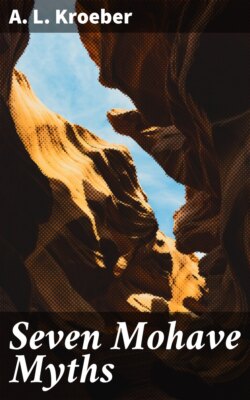Читать книгу Seven Mohave Myths - A. L. Kroeber - Страница 14
На сайте Литреса книга снята с продажи.
Оглавление[34] An insect that lives in trees, does not fly, and looks like haltôθa.
[35] "Tšese'ilye was her name"—her father's, ante. About this confusion, see note 58. Another confusion is that in 29 it is Sun's daughter (wife no. 2) who goes away and Tšese'ilye who gives birth to the hero, as confirmed by his now sending her home west; whereas in 82b, 86, 87, he travels east to rejoin his mother, and in 90 her father is Sun.
[36] Where she had come from, if she is Tšese'ilye (or Tšese'ilye's daughter) and not Sun's daughter.
[37] Kwaθki-mareko, almost as deep as a pot.
[38] Travel by firebrand is a Yuman habit. Rio de los Tizones was the first European name given the Colorado.
36. That night when there were only the two of them there, the boy told the old man, "I am going to leave you. You stay here. Listen to what I will do." He thought he would do something to the people that played with his father's bones, but he did not yet know what. Then the old man Hatpa-'aqwaoθtše said, "It is well. You will die somewhere and I will cry for you here. That will be all. I can live. I am not very old yet. I can go about begging for food. I will come to people's houses and they will give me something to eat, for they will know me and that I am poor and hungry. I shall live like that staying on here." Then in the morning they all came there to play ball again. They had short shinny sticks, nearly straight, not long and curved.[39] When the boy saw them, he went outdoors, took earth and rubbed it on himself, so that no one would see him, or know him; for he wanted to take away their ball. So he turned himself into a halye'anekītše lizard.[40] Now they played. They came near him: he was lying by the side of the playing field: no one knew it. Now they played toward the south and back again, four times, and one side won. Then the boy seized the ball: no one saw him take it: no one knew he had it. He went back to his house. Now he wanted to throw it, but did not throw it yet: he wanted to know in which direction to throw it.[41] First he wanted to throw it north, but did not. Then he was going to throw it south, then west, then east. He kept it in his hand and stood there. (1 song.)
[39] Of bone? The ordinary Mohave shinny stick is a yard long and definitely bent at the end.
[40] The tip of its tail is blue: cf. note 95.
[41] Typical hesitation of Mohave narrative.
37. When he had told (kanavk) of the far heavens (amaiyêitše) four times, still holding the ball, he struck the ball with a stick and it flew west like a meteor (kwayū). It fell in the mountains and broke them and killed the people who lived on them: it killed them all. The boy stood and heard. He thought, "No one is there now: they are all killed!" Nume-peta and Pukehane said, "That boy! I knew he would do it: he has killed all those people. He will kill us too. You shall see: he will do that." The boy did not hear them, but he knew (what they said). He was glad and laughed and shouted and ran. He ran north to Avi-kwutapārva: There he stood. (2 songs.)
